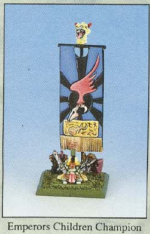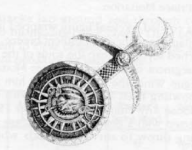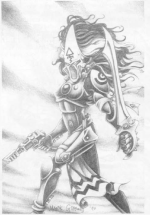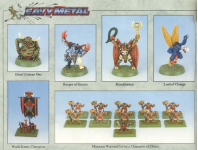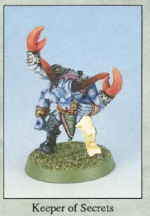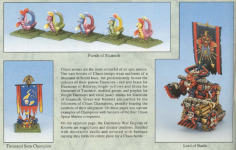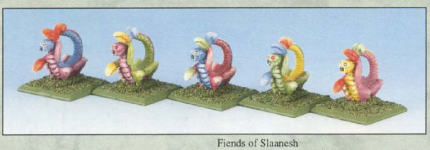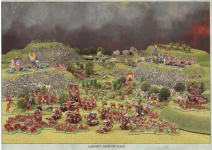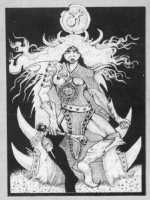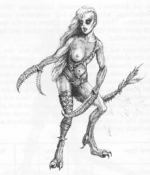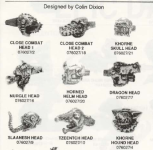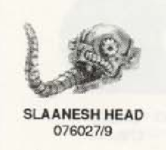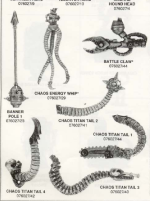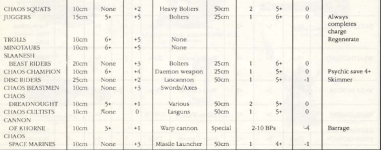THE ELDAR ARMIES
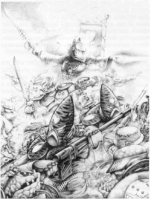
Compared to that of a human, the life of every Eldar is closely structured. As Eldar reach maturity they choose a profession or way of life which they devote themselves to absolutely, perfecting their skills until they become totally accomplished. Having reached the pinnacle of achievement in one sphere they begin another, devoting themselves wholly to a new way of life until they gain complete mastery over it. This process is called the Eldar Path. The Eldar Path affects the whole structure of Eldar society including its armed forces. Craftworld societies are led by Eldar whose current development is the Way of the Warlock, a stage in which the Eldar devotes his life to developing his psychic nature. There are many kinds of Warlock. Some are powerful battle-mages able to mould thunderbolts of pure power and send them hurling against their foes. Others are able to predict the future and manipulate it to some degree by means of the Eldar Runes. These Eldar are very important to the Craftworld: they are its leaders and protectors, and they guide the Craftworld through space. In battle the Warlocks coordinate the Eldar battleplan, using runic predictions to determine the best tactics. The most valuable of the Craftworld’s fighters are its Aspect Warriors. These are Eldar who are currently pursuing the Way of Warrior on the Eldar Path. There are different kinds of Aspect Warrior, each specialising in a particular kind of warfare and way of fighting. Aspect Warriors can sometimes become trapped, unable to continue the Eldar Path and doomed to spend the rest of their lives as warriors. These individuals are called Exarchs, and they are the most powerful fighters of all.
Other Eldar fight as Guardians - they are not pursuing the Way of the Warrior, but in times of need they are ready and able to fight for their Craftworld. Guardians fight in Grav-tanks and operate machinery of war in addition to fighting as infantry, so they are a vital part of the Eldar force. All the Eldar are aware that Slaanesh waits for them in the warp, and that the Great Lord of Pleasure will take what opportunity he can to destroy them. When an Eldar dies his soul is cast into the warp where it is hunted down by the daemons of Slaanesh and torn apart. To avoid this horrible fate, every Eldar wears a gem around his neck called a Waystone. Should the Eldar die the Waystone will catch his soul, preventing it from being drawn into the warp and consumed by Slaanesh, The Waystone can be implanted into the superstructure of the Craftworld itself, where the soul can reside with the souls of all the other Eldar dead. An Eldar Waystone can also be placed inside a Titan, or Wraithguard, so that it can live again in material form. These Wraithguard form a further part of the Craftworld’s fighting forces.
CRAFTWORLDS
Even the Eldar don’t really know how many Craft Worlds survived the final holocaust. Some were caught in time-vortices as they fled the destruction of their worlds and cast into the depths of time, others were hunted down by Slaanesh and destroyed, a few were set upon by mortal enemies, There are many small Craftworlds which remain obscure, including some whose populations have declined to a level no longer sufficient to survive. These very small Craftworlds are doomed to extinction. The largest and most well known Craftworlds are Alaitoc, Iyanden, Beil-Tan, and Saim-Hann, Each Craftworld is an independent Eldar nation, but they are all interconnected by tunnels through the warp, so it is common for one Craftworld to send reinforcements to help another. It has been known for one Craftworld to fight against another, although such occasions are rare amongst the Eldar. Sometimes the Eldar will fight alongside humans, especially if their enemy is Chaos, but there is no recognised alliance between the two races. Rather it is that they both have common goals and little to gain by fighting each other. Sometimes humans will settle worlds which the Eldar consider their own, in which case a brief war usually settles the matter one way or the other.
HARLEQUINS
Amongst the strangest of all Eldar are the followers of the Great Harlequin: the last living god of the Eldar and eternal opponent of Chaos. The Harlequins have a particular hatred of the Chaos God Slaanesh, Lord of Pleasure and Bane of the Eldar. The Harlequins roam from one Craftworld to another to perform the ancient dance portraying the great decimation of the Eldar race by Slaanesh, the fall of Khaine into the material universe, and the endless struggle of the Great Harlequin against Chaos. The Harlequins are warriors of considerable power and can be found in the armies of all Craftworlds, especially fighting their great enemies the forces of Chaos, Harlequins fight in a single formation called a Harlequin Troupe, which consists of 4 Eldar troop stands. A special Harlequin model is included in the Eldar War Host miniature set, though you can also use other Eldar models to represent them if you wish. As the Harlequins wear all sorts of different clothes it is quite appropriate to mix a few Guardians or the odd spare Aspect Warrior onto the bases. Eldar Harlequins wear colourful patterned clothing and each one wears a slightly different costume.
For example, some Harlequins wear quartered clothing with one arm and the opposite leg in one colour, such as blue, and the remaining arm and leg in a contrasting colour, such as red, Harlequins check morale like normal troops, unless they are fighting a Chaos force, in which case they need never check morale. Harlequins are ferocious hand-to-hand fighters, the more so because the Great Harlequin watches over them and gives them extra power when they most need it. In close combat each Harlequin stand rolls 2D6 and adds its close assault factor of +6 just like other troops. However, if a Harlequin stand loses a combat the player may re-roll the 2D6 score. This represents the watchful spirit of the Great Harlequin directing extra power to his loyal followers.
ELDAR WRAITHGUARD
To the Eldar the prospect of death represents a final horror unthinkable to a human and unimaginable to an Ork. When an Eldar dies his consciousness passes into the warp where The Enemy, Slaanesh the Bane of the Eldar and Great Power of Chaos, awaits to consume it. Every Eldar wears around his neck a smal] gem called a waystone, the purpose of which is to absorb its owner's consciousness should he be killed, thereby cheating Slaanesh of his quarry and saving the Eldar from a fate that is literally worse than death. Waystones are implanted into the Wraithbone skeleton of the Eldar Craftworlds, releasing the spirit of the dead Eldar into the fabric of the Eldar Craftworld itself. Waystones can also be implanted into machines, and the consciousness they contain becomes the controlling element of the machine, allowing the Eldar to live again in a new form. The Wraithguard are robotic bodies with Eldar waystones implanted inside them. They can move and act much like living creatures, motivated by consciousness of the dead Eldar they contain. This consciousness is not quite the same as that of a living person, but more like a dream-state, perceiving things around about in a shadowy and disconnected way. When the Eldar go to war they are frequently accompanied by the dead in the form of Wraithguards and Eldar Dreadnoughts.
Wraithguard units perceive the world in a shadowy, insubstantial way, absorbing the emotions of living Eldar around them as much as anything else. To represent this an Eldar Wraithguard unit will always remain within 10cm of a living Eldar unit where possible to do so. If they find themselves beyond this range at the start of the movement phase, perhaps because casualties or some other unforeseen event has caused them to become separated, they automatically receive charge orders and move towards the nearest living Eldar until they are within 10cm. This will prevent the Wraithguard firing that turn, and they can only enter close combat if the Eldar unit they are moving towards is engaged in close combat. Assuming the Wraithguard begin their turn within 10cm of living Eldar they automatically receive the same orders as the closest living Eldar unit. If the closest unit is a Warlock any order can be placed. This represents the Wraithguard responding to the psychic needs of the living.
THE ELDAR CRAFTWORLDS
The Eldar Craftworlds drift through the void of space, far away from the inhabited planets of other races, Each Craftworld preserves a little of the once great Eldar civilisation which was destroyed thousands of years ago by the Chaos God Slaanesh. Every Craftworld shelters the survivors from one of the ancient Eldar planets, and each has its own cultural traditions and separate identity amongst the Eldar race, Although each Craftworld has troops and vehicles coloured in a variety of ways, their traditional colours remain common.
